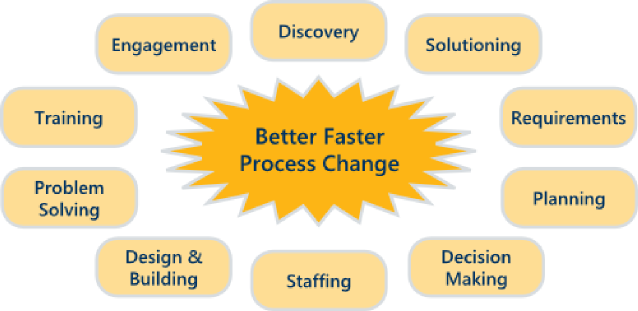ActionMap Toolkit Overview
Commitment to Take Action
Processes change when stakeholders’ knowledge, interests, and itentions change. Until those subjective changes occur actual physical process change is difficult to successfully accomplish and sustain.
For processes of any significant complexity, collaboration among multiple stakeholders is required to achieve those subjective changes. This collaboration often requires a series of meetings.
ActionMap is specifically optimized to rapidly and reliably create the key results of that collaboration: strong shared understanding, agreement and commitment to take action, supported by high quality process models, evaluations and action plans.
The result is a reduced number of meetings and earlier realization of process change benefits.
Here’s how it works.
SaaS Application
The ActionMap Toolkit is a desktop/laptop-based SaaS application that uses the Chrome browser as its client. The Toolkit runs inside a standard e-meeting service that is provided by the subscriber.
The application is used the same way as if sharing a document or spreadsheet in an e-meeting.
ActionMap meetings can also be conducted in person using overhead projectors and other media.
Scope of Use
The ActionMap Toolkit can be applied to virtually any activity that might be considered a process, and to any level or manner of change in that process.1 The Toolkit is able to do this because the underlying method focuses on stakeholders’ process knowledge in addition to the specific mechanics of the process in question.
Specific process knowledge varies with each process. However process knowledge, process change and process thinking operate according to patterns that are fairly universal. ActionMap supports, strengthens and leverages those patterns. (For more on these patterns, please see our “secret sauce” page.)
ActionMap Toolkit Main Page
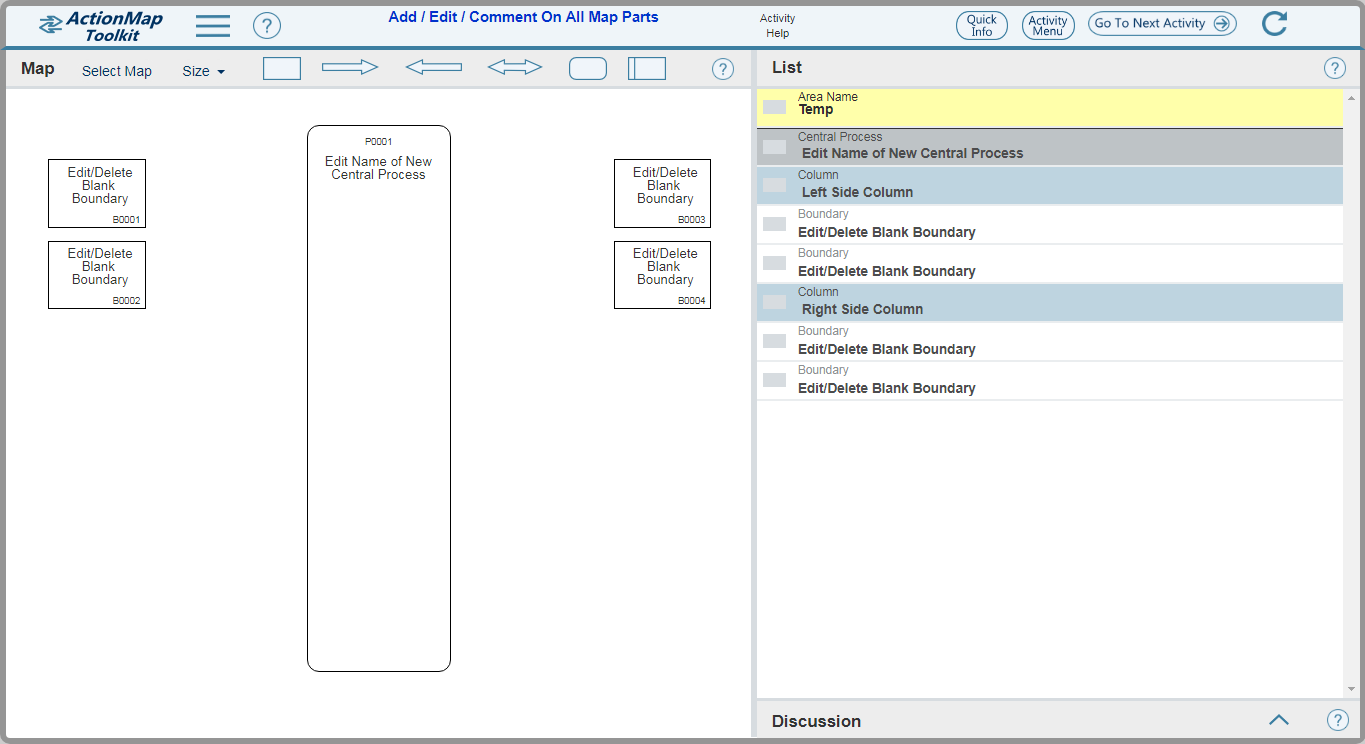
Meeting Roles
The Toolkit can be used in otherwise standard meetings, following introductions, agenda and guidelines. Use of the Toolkit can be the main or only item on the agenda; the Toolkit can provide the remaining meeting structure.
An “operator” runs the Toolkit software and provides “just-in-time” explanations of the method, while “participants” (representing different stakeholder groups) contribute the meeting content using e-meeting audio and chat.
Operators need no advance knowledge of the meeting content and participants need no advance knowledge of the ActionMap method. Meetings can start with only a few minutes explanation for participants.
Model Plan Area: The Primary Work Product
The Toolkit produces a high-level work product called a Model Plan Area: an area of activity that is both modeled and planned for. Model Plan Areas can cover virtually any activity that might be considered a process.
A Model Plan Area consists of one or more process maps and associated information. Process maps can be thought of as views into the activity that makes up the Model Plan Area. Maps can represent current state, future state or plan.
Main Page
All the work in an ActionMap meeting is done on a single page layout called the Main Page (screenshot above). The Main Page has a Map on the left and what we call a List on the right. The List is for capturing and organizing text comments about the Map.
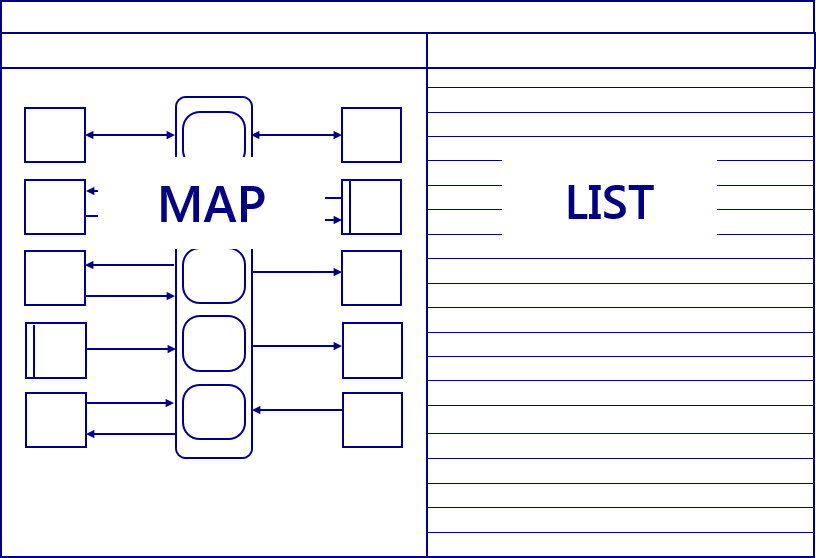
Map
ActionMap uses a single highly structured diagram format for maps, which is logically equivalent to a system
activity diagram (as seen above).
Maps can be created either by adding items to the List or by simple drag and drop. The maps are intended to be used flexibly, covering a range from structured sketches to engineering-grade specifications.
The maps focus on showing the actual, real transactions in the Model Plan Area, that is, the “stuff” that goes between people, organizations and systems.
Our experience is that when transactions are illustrated in this way, they trigger clearer experiential memories about the process, compared to people’s responses to other diagram formats. Meeting participants then contribute their knowledge and interests about such transactions more energetically and with less prompting.
That energetic response to specific transactions is a primary “motive force” that drives the ActionMap method.
List
The map provides a visual, analytic focus for prompting, sharing and capturing stakeholders’ process knowledge, assessments, interests and priorities with respect to the content of the map. All of this information is captured in short text phrases or votes, on the List.
This information is also all captured in specific structured ways, and is all associated with specific elements on the map (or the entire map). As a result all subjective input has objective grounding.

Capture, Organize and Share
Between the Map and the List, this approach covers virtually everything that can be said about the process that is under review. It can also capture and organize that information very quickly, essentially as fast as it is contributed. This maintains the meeting pace and energy.
The overall procedure goes back and forth between mapping (objective information) and “evaluating” (subjective information) so that people do not get bored (from too much mapping) or argumentative (from too much evaluating.)
ActionMap Main Cycle
The interests and priorities are then put through a compact, participant-driven improvement cycle of filtering, brainstorming and re-prioritizing, leading to the identification, assignment and scheduling of specific “do now” action items. The Main Cycle can be used flexibly. Many meetings produce strong results by just performing the Modeling stages.
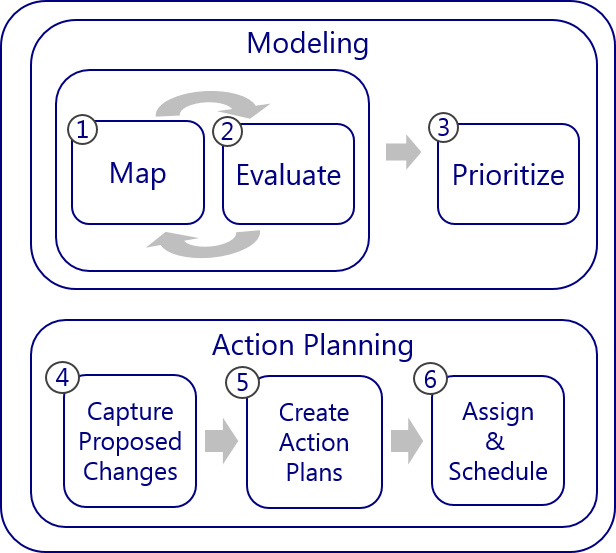
Export, Re-use and Share after Meetings
Model Plan Areas can be exported as encrypted datasets for re-import, and exported to PowerPoint and Excel for broader distribution and further information collection.
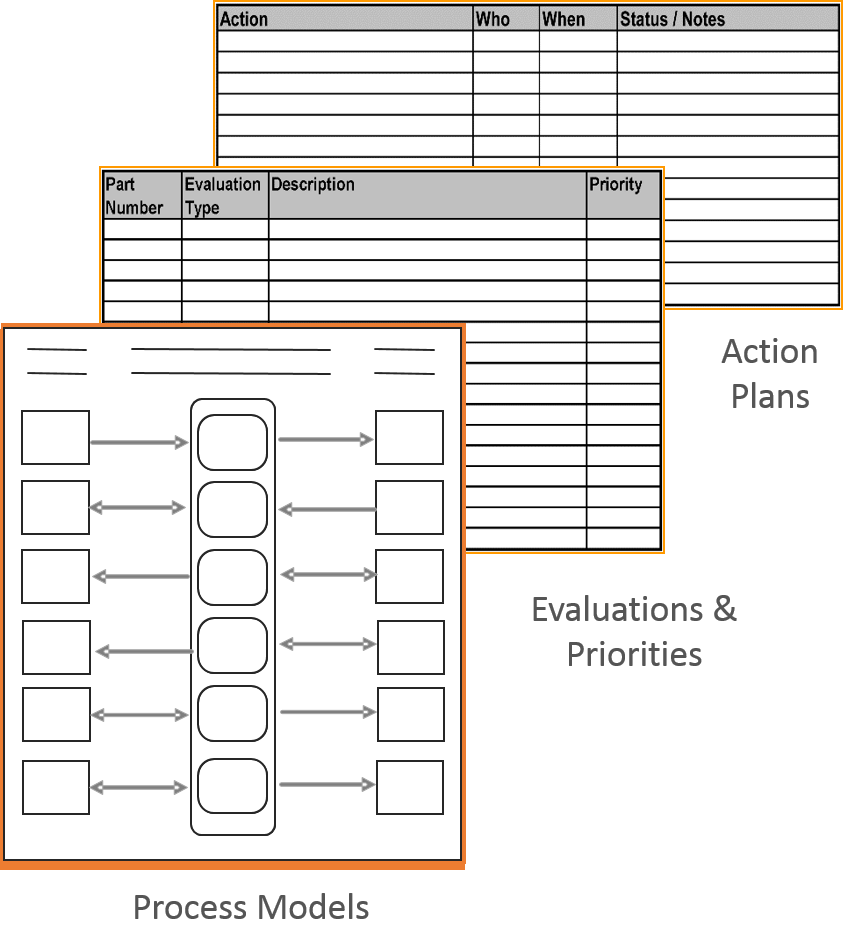
Implementation & Training
Use of the ActionMap Toolkit is provided on the basis of individual, single-user month-to-month subscriptions. System requirements include Chrome on a PC or laptop with Windows 7 or later or Mac OS.
Use of the Toolkit requires no technical deployment, no organized rollout, no extended training and no long-term commitment.
Application support includes self-training materials, help pages and an email ticket system. The software has extensive built-in step-by-step guidance.
The Toolkit can be applied to personal work immediately on completing signup. Confidence in using the software can be achieved within an hour of use.
Large Scale Change Initiatives
An ActionMap group session can be seen as a general purpose tool for creating increments of progress in process development and improvement.
These results can be added together to produce rapid progress in change initiatives that cover large organizational areas.
This is done by conducting multiple sessions, both hierarchically and in parallel, for engagement, discovery, analysis, design, planning and implementation.
The results of these multiple sessions can be collected and organized in further methods including Program Management, Project Management, Agile, BPM and Lean/Six Sigma.
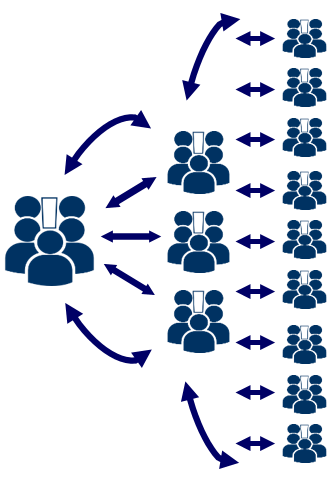
Notes:
1. A major prerequisite for successful use of the Toolkit in group meetings is that attendees need to be willing to actively participate and contribute. Prerequisites for that include:
> a reason to work together,
> a shared starting point for process change,
> good will, and
> mutual trust.
In some cases these values are not sufficiently present. This can happen in situations which involve:
> highly opposed or secret agendas (e.g. not wanting the process to change)
> significant organizational change (e.g. not knowing who the process owners will be)
> large differences in organizational rank within the group (e.g. line staff sharing task details with VPs)
> the parties needing to cross-educate each other on high-level capablities and interests (e.g. potential strategic partners meeting for the first time.)
In addition there are situations in which introducing a software application of any kind imposes too much overhead on the meeting. In those cases the ActionMap method can be used in different media (e.g. paper, flipcharts, whiteboards, office automation tools) or simply used as a personal framework for conducting a conversation.
Using the software teaches people how to use the method in other media.
Accelerate Innovation
